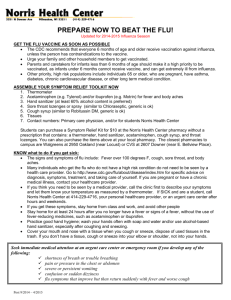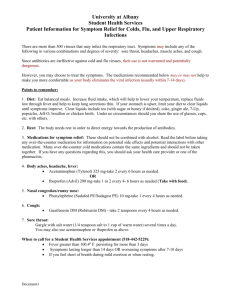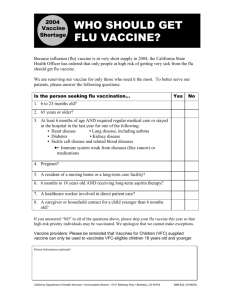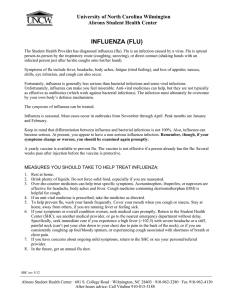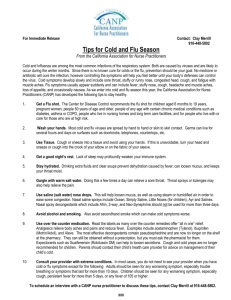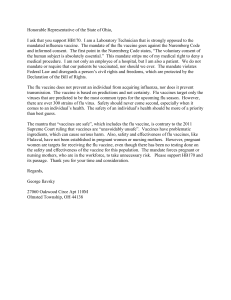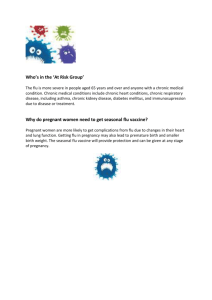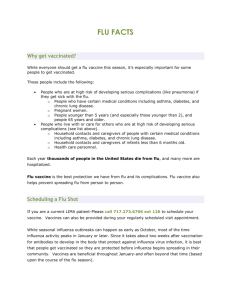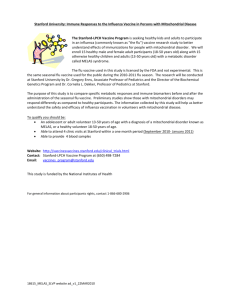I- SYMPTOMS: The symptoms of influenza include fever, chills body
advertisement
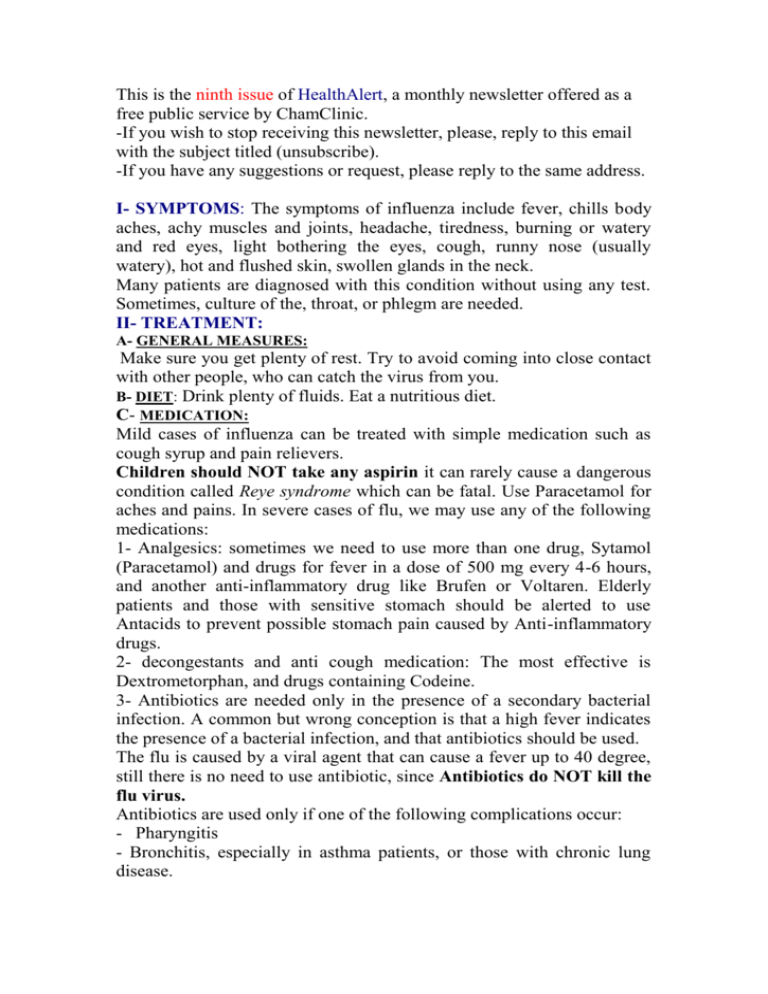
This is the ninth issue of HealthAlert, a monthly newsletter offered as a free public service by ChamClinic. -If you wish to stop receiving this newsletter, please, reply to this email with the subject titled (unsubscribe). -If you have any suggestions or request, please reply to the same address. I- SYMPTOMS: The symptoms of influenza include fever, chills body aches, achy muscles and joints, headache, tiredness, burning or watery and red eyes, light bothering the eyes, cough, runny nose (usually watery), hot and flushed skin, swollen glands in the neck. Many patients are diagnosed with this condition without using any test. Sometimes, culture of the, throat, or phlegm are needed. II- TREATMENT: A- GENERAL MEASURES: Make sure you get plenty of rest. Try to avoid coming into close contact with other people, who can catch the virus from you. B- DIET: Drink plenty of fluids. Eat a nutritious diet. C- MEDICATION: Mild cases of influenza can be treated with simple medication such as cough syrup and pain relievers. Children should NOT take any aspirin it can rarely cause a dangerous condition called Reye syndrome which can be fatal. Use Paracetamol for aches and pains. In severe cases of flu, we may use any of the following medications: 1- Analgesics: sometimes we need to use more than one drug, Sytamol (Paracetamol) and drugs for fever in a dose of 500 mg every 4-6 hours, and another anti-inflammatory drug like Brufen or Voltaren. Elderly patients and those with sensitive stomach should be alerted to use Antacids to prevent possible stomach pain caused by Anti-inflammatory drugs. 2- decongestants and anti cough medication: The most effective is Dextrometorphan, and drugs containing Codeine. 3- Antibiotics are needed only in the presence of a secondary bacterial infection. A common but wrong conception is that a high fever indicates the presence of a bacterial infection, and that antibiotics should be used. The flu is caused by a viral agent that can cause a fever up to 40 degree, still there is no need to use antibiotic, since Antibiotics do NOT kill the flu virus. Antibiotics are used only if one of the following complications occur: - Pharyngitis - Bronchitis, especially in asthma patients, or those with chronic lung disease. - Sinusitis, the symptoms of sinusitis may appear a few days after the onset of the flu, and include: pressure around the eyes, frontal headache, continuous mucus dripping in the throat, and cough at bedtime. It is important to stress the fact that the presence of cough or a sore throat alone does not indicate the presence of an infection, Bacterial infection is diagnosed by the careful examination by a physician. 4- Bronchodilators: Ventolin, Azmex and others, are used when there is wheezing and tightening of the airways, especially in the asthmatic patient. D- EXERCISE: Avoid exercise until you are feeling better. III- VACCINE: The flu vaccine protects most people from catching the flu, although it doesn’t work every time. You need to receive the vaccin every year, because the virus changes yearly. It is given in the autumn, just before flu outbreaks tend to occur. The vaccine should especially be given to the elderly, people with chronic diseases that make them more prone to catch the flu (such as diabetics and people with heart and lung disease), and people whose work puts them in contact with patients. However, anyone can receive the vaccine, unless they are allergic to it or allergic to eggs. You should not receive the vaccine while you have a fever or a fresh infection. Fortunately, People who cannot receive the vaccine can be protected during an epidemic by taking a drug called amantadine. The group of patients mentioned above should also receive the Pneumovax, a vaccine that protects from Bronchitis and Pneumonia IV- COMPLICATIONS: Most young, healthy people recover from influenza without problems. However, older or sicker patients may have complications, including Bronchitis and Pneumonia, Sinusitis, pharyngitis. With best regards of ChamClinic Cham Clinic P.O.Box: 250069 5 Al-Tirmizi St. Damascus, Syria Tel: 3062 E-mail: hdadouch@net.sy Your Partner For Help And Hope
